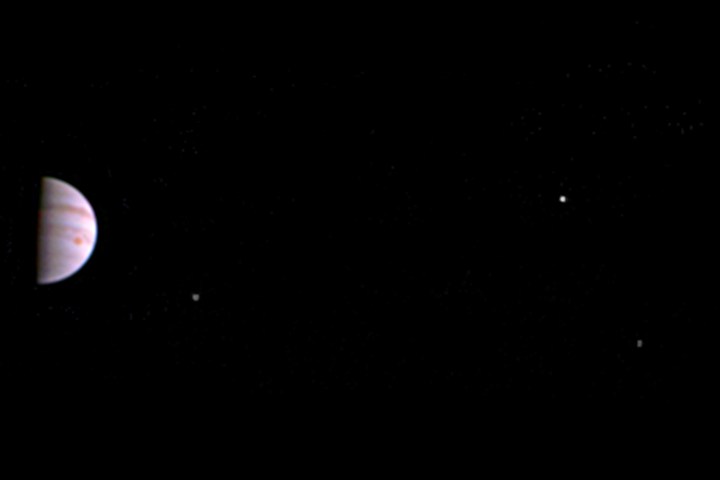
“This scene from JunoCam indicates it survived its first pass through Jupiter’s extreme radiation environment without any degradation and is ready to take on Jupiter,” said Scott Bolton, principal investigator from the Southwest Research Institute in San Antonio, in a statement. “We can’t wait to see the first view of Jupiter’s poles.”
Juno rendezvoused with Jupiter on July 4, firing its main engine into the Jovian orbit while many of us were shooting off fireworks. Six days later, the spacecraft’s visible-light camera was powered on and snapped this photo while 2.7 million miles away from Jupiter. In the image, we can see three of the planet’s moons — Io, Europe, and Ganymede — as well as the Great Red Spot in Jupiter’s atmosphere.
We’ll have to hold out for a few more weeks before high-resolution images return from Juno, though, as the spacecraft begins to dip just a few thousand miles above Jupiter’s dense cloud layer for 37 consecutive flybys.
“JunoCam will continue to take images as we go around in this first orbit,” said Candy Hansen, Juno co-investigator from the Planetary Science Institute, Tucson, Arizona, in the same statement. “The first high-resolution images of the planet will be taken on August 27 when Juno makes its next close pass to Jupiter.”
During these flybys, Juno will attempt to peek beneath the planet’s clouds to study its auroras, magnetosphere, atmosphere, and structure.
Editors' Recommendations
- Look at what a NASA Mars orbiter spotted from 180 miles away
- NASA shares majestic images of orbital sunrise captured from ISS
- NASA’s anti-asteroid DART mission sends back its first images
- NASA’s Juno spacecraft peers deep into the atmosphere of Jupiter
- NASA’s Juno spacecraft, in orbit around Jupiter, is 10 years old this week



